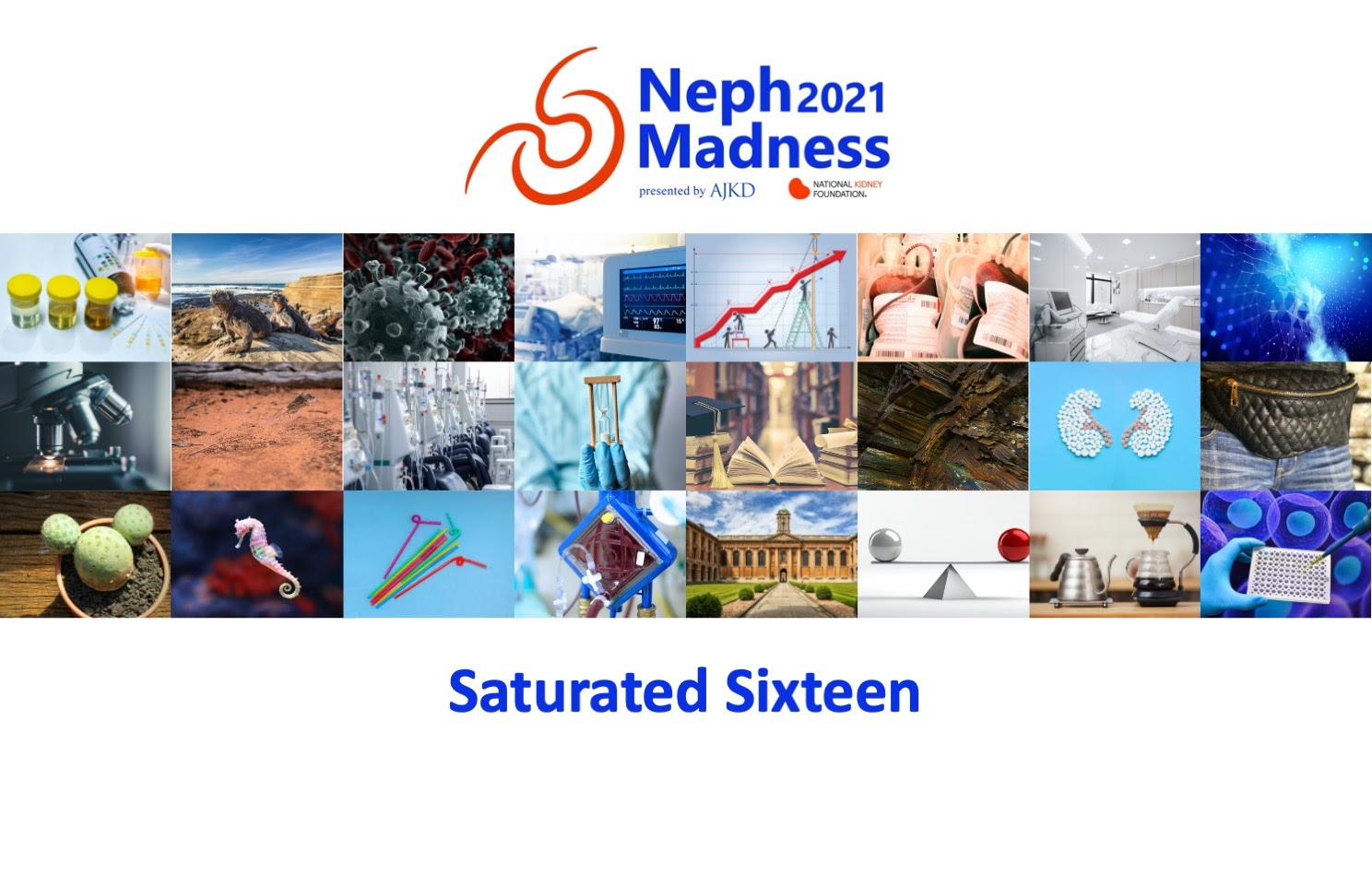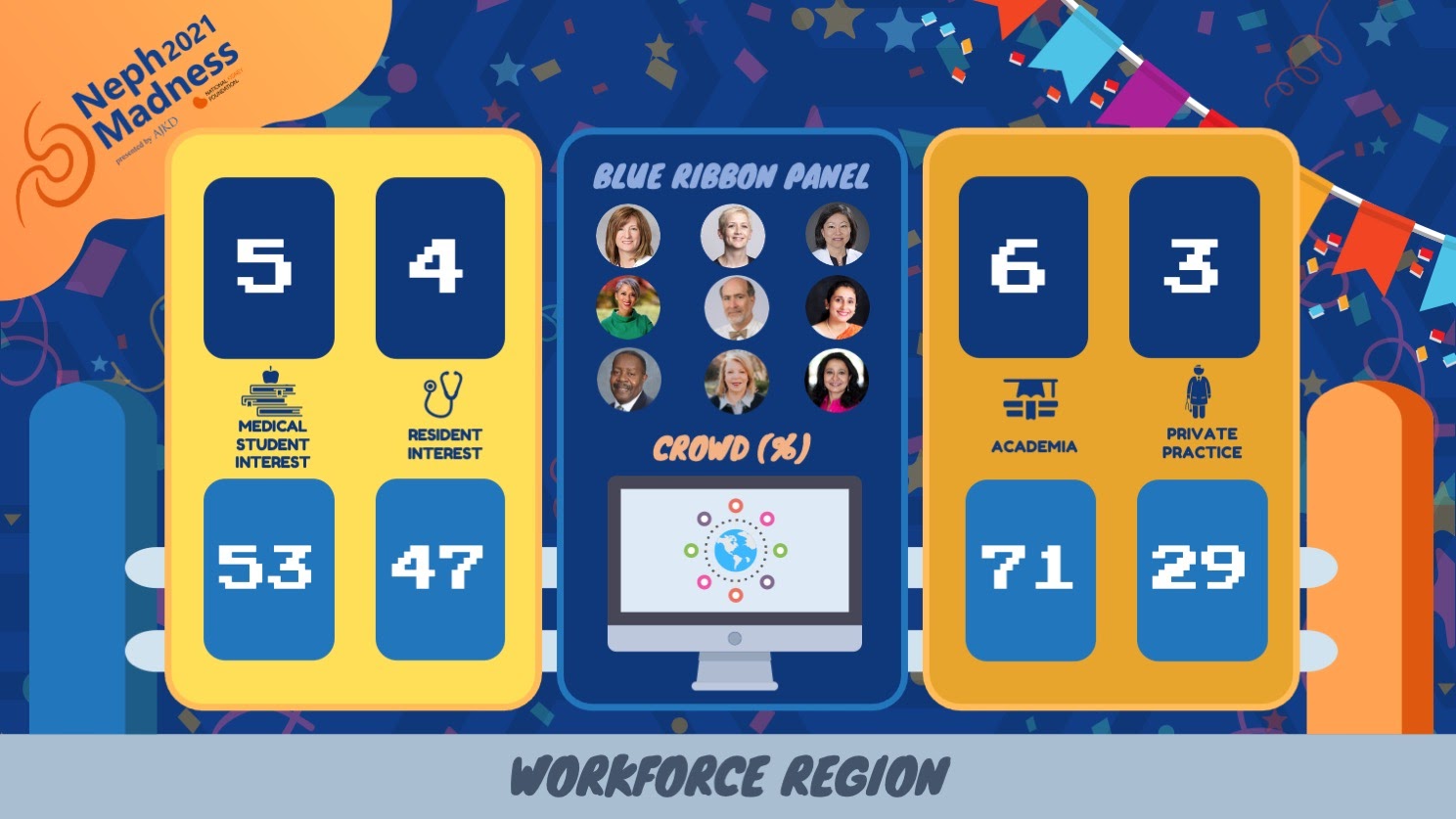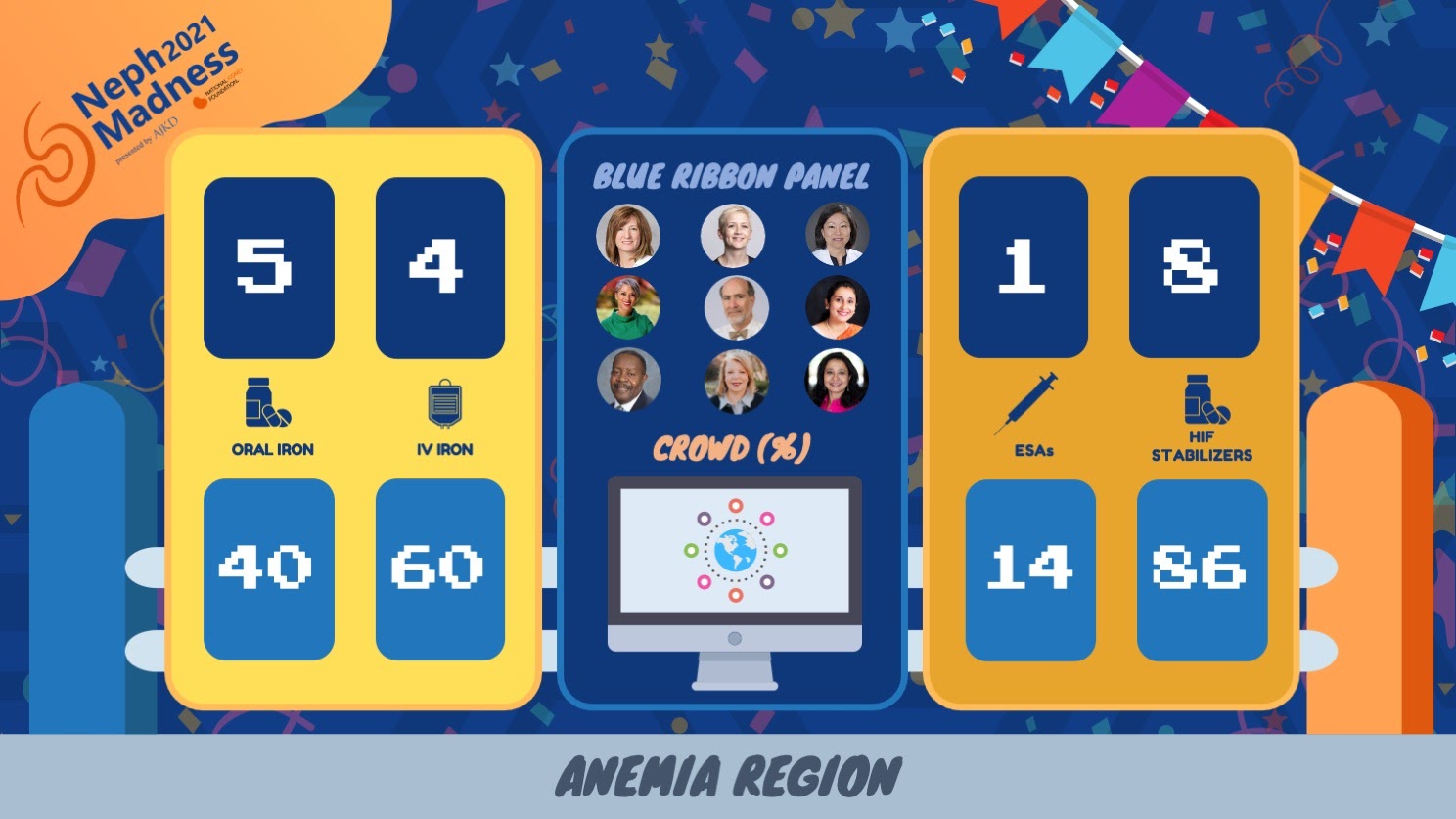#NephMadness 2021: The Saturated Sixteen
The first round results from NephMadness 2021 are in! Who’s up? Who’s down? Who’s in? Who’s out? Which team was your bracket buster? Where did the Blue Ribbon Panel go wrong? Tweet your reactions with hashtag: #Saturated16 (and #BlueRibbonFail if you’re feeling salty!)
We present the Saturated Sixteen:
Current Standings | Match Results | #NephMadness
Liquid Biopsy Region
Staining Techniques fell short when trying to take on Microscopy Techniques. Team Microscopy Techniques with the easy win here.
Microscopy Techniques wins 6-3
Comments from the BRP:
“Sometimes the original can’t be topped. I love a stain on hardwood floors, but on my urine, I think I’m good.“
“There is no stain without microscopy.“
“Tried and true microscopy has all the fundamentals; staining may be pretty, but the true benefit for making a diagnosis in the skilled hands of a nephrologist remains unproven.“
“I think the staining techniques provided the most new information.“
“I see overlap here, but the staining is lovely.“
This was a tight match up with the evenly matched Urine Microscopy for GN and Urine Microscopy for ATN, but in the end a last second buzzer beater sent Urine Microscopy for GN through to the Saturated 16.
Urine Microscopy for GN wins 5-4
Comments from the BRP:
“The general internist in me has appreciated those moments on the teaching scopes with nephrologists leading me to the promised land of muddy brown casts. Even though Urine micro for GN is bloody amazing to some, with ATN being such a common concern in my GIM world, micro for ATN gets my vote.“
“Biopsies remain king for GN.“
“I would be helpless without a urine microscopy in GN …. can’t even suspect it … It’s the first essential step in diagnosis and management of GN.“
“This is a close call, as urine sediment exam should be a fundamental part of the evaluation of all patients with kidney disease; however the significance associated with acanthocytes and RBC casts wins over muddy brown casts and RTECs.”
“Nothing more exciting then making this GN dx.”
Animal House Region
The crowd left before this match up even finished, as Team Hopping Mouse pounced all over Team Marine Iguana, leaving them tied up in miles of Loops. Hopping Mouse walks into the next round with the easy ‘W.’
Hopping Mouse wins 8-1
Comments from the BRP:
“Concentrating urine to a semi solid state makes this tiny creature the original kidney superhero.“
“You had me at ‘crocodile tears.’“
“Iguana see you top the hopping mouse!“
“While both animals manifest brilliant evolutionary adaptations, water conservation by the hopping mouse is the more elegant and sophisticated. If only our own kidneys could evolve faster as climate change increases water scarcity.“
“Loved the physiology of this session. Tough choice. I did love the sneezing salt adaptation but was most intrigued by the concentrating ability of the mouse!“
Despite having no glomeruli, Team Seahorse swam circles around Team Hagfish and its slimy defense. A slam dunk for Team Seahorse!
Seahorse wins 6-3
Comments from the BRP:
“It’s close but the Hagfish seems more likely to impact on human disease than the seahorse – though the seahorse’s egalitarian attitude towards childcare could be a model for gender equity in nephrology.”
“Insights from the aglomerular nephrons of the seahorse may provide insights for the construct of bioartificial kidneys that don’t require filtration to optimize solute excretion.”
“I had no idea all that was going on with my pet seahorses I had as a kid.“
COVID-19 Region
COVID-19 in Transplant looked like a 16 seed and not the kind that busts brackets. COVID-19 in Dialysis won in a landslide.
COVID-19 in Dialysis wins 8-1
Comments from the BRP:
“The impact of the pandemic on transplantation has increased the numbers of people on dialysis, the flow on effect from this will impact on nephrology and our patients for the next decade.“
“Both are important but again, the impact is so great when it comes to COVID and HD. Working at a safety net hospital, this is thrown into relief–COVID and HD gets this round.“
“Dialysis is more widespread a treatment as compared to transplantation globally. More dialysis patients as well as HCWs suffered during the pandemic not only from the infection but the associated chaos, confusion and moral distress associated with offering dialysis to COVID patients. Many patients lost due to unavailability of dialysis in the pandemic. This topic has a more universal appeal.“
“COVID in Dialysis touched on inequalities in our delivery of dialysis and though specific to COVID I think these issues have always been present and will continue to be present. Hopefully by us being more aware we can make some real changes.“
“Major impact in KT in all aspects.“
How close is close in NephMadness? This is as close as it gets… Team Tubular Injury in COVID-19 just barely made it into the Saturated 16.
Tubular Injury in COVID-19 wins 5-4
Comments from the BRP:
“There’s clearly still so much to learn from COVID-19 but research on tubular injury seems more likely to result in meaningful patient outcomes over the next 5 years.”
“Where ACE2 goes, I will follow.”
“Still lacking the complete pathophysiology of the mechanism of ATN in COVID and all the contributing factors. Still unaware if is it COVID that specifically causes the ATN or is it like any other MODS.”
“While the development of glomerular injury in COVID is interesting, AKI represents the much larger clinical problem.”
“Nice complete writeup of the issues.”
ICU Nephrology Region
Dialysis Timing in Surgical ICU got off to an early lead right out of the gate and despite a strong finish and a full court press, Dialysis Timing in Pediatric ICU couldn’t close the gap.
Dialysis Timing in Surgical ICU wins 6-3
Comments from the BRP:
“As more children survive ICU into healthy adulthood, the impact of AKI management is likely to increase the numbers of adults with CKD. Improving AKI management is important.“
“The stakes are high in all critically ill patients–but with children they feel even higher. This one was tight for me–great info on both but the kids win. (Blame it on me being Med-Peds.)“
“Tend to have a lower threshold for dialysis in surgical ICUs though unsure if that agrees with the available evidence. I find the evidence equipoise and would want to learn more.“
“Data based on STARRT-AKI drives this question.“
“Hopefully we can share this synopsis with our critical care colleagues!“
AKI Etiology with ECMO played strong defense but in the end Dialysis with ECMO’s offense and inability to miss a shot led to an easy win.
Dialysis with ECMO wins 6-3
Comments from the BRP:
“The practical problems,technical aspects and difference in management of patients on ECMO is still a little stressful.”
“Dialysis with ECMO — this may be the winner …. Final 4 prediction.“
Workforce Region
This was one of the most exciting closely fought matchups thus far in the tournament. After triple overtime, Medical Student Interest hit a buzzer beater to take a 1 point lead over Resident Interest to win the matchup.
Medical Student Interest wins 5-4
Comments from the BRP:
“In residence, one tends to enjoy and get exposed to the entire magic of Nephrology including its practical applications. The physiology of nephrology sans the practical application can be intimidating and may make a medical student shy away from this magical branch of medicine. It’s when one does Internal medicine and falls in love with it does one realize its closeness to nephrology.”
“Start ’em early!”
“This match goes into overtime, but is narrowly won by the Residents. Increasing medical student interest and resident interest are both critical, but there is too much risk of attrition between medical school and applying for fellowship.”
“I think we need to work at both the Medical Student and Resident Level to increase our workforce. However, I think we have a clearer sense of how we can make changes in early years of residency and likely have more sway in making those changes than at the medical school level.”
“The earlier you strengthen the tubule–I mean pipeline–of future nephrologists, the better. Med Students for the win.”
Despite a close first half of this game, Private Practice came back out from the locker room after halftime flat on their feet leading to an easy victory for Academia.
Academia wins 6-3
Comments from the BRP:
“Private practice offers the best of both worlds.”
“We need more academics….”
“Paradoxical for an academic to go with private practice, but it is the private practices that will provide the majority of the care – and can still teach.”
“I think we need to show the diversity that nephrology has to offer. Also, increasing the happiness of the current workforce (which is mostly private practice) will help improve the reputation of nephrology as a whole.”
“It shouldn’t be controversial to say that if we’ve learned nothing else from COVID-19 it’s that healthcare is a human right and as such access should be equitable. We should work to ensure that socialized public medicine is as attractive as private practice.”
Anemia Region
The perennial favorite IV Iron had been hot from the 3 point line making them the early favorite. However tonight, the 3-pointers just weren’t falling and Oral Iron came up with the big win.
Oral Iron wins 5-4
Comments from the BRP:
“Shifting away from IV iron preparations is more convenient for patients (particularly pre-ESRD) and should be more economical. Given the efficacy of the new oral agents, even if not as good as IV iron, they should be good enough.”
ESAs looked old and tired on the court and HIF stabilizers youth led and energy to an easy win.
HIF stabilizers wins 8-1
Comments from the BRP:
“The jury is still out on the comparative efficacy and safety of the new kids on the block (HIF stabilizers) but if the risk profiles are similar advantage of oral dosing will carry the day (assuming pricing is not excessive).”
“HIFs next year.”
“HIF HIF hooray.”
Primary Care Region
Strong Defense led to an easy victory for CKD Primary Care over Transplant Primary Care!
CKD Primary Care wins 6-3
Comments from the BRP:
“We can’t deal with the burden of CKD without the primary care physician.Transplantation is just a sub plot of the main movie!!”
“Improving care for CKD in the primary care setting is our best chance for bending the curve on the rising number of patients with CKD. Improving screening of patients at risk (1/3 of the adult population), improving treatment of BP, and increasing appropriate use of RAS blockade and SGLT2i will have the greatest impact.”
“Transplants should become primary!”
“Hopefully many of our primary care colleagues will join in this discussion. I know they all want to provide the best care possible but often do not know what the entails for our CKD population.”
“Whew. This was a tough one. But I have to go with greatest impact for base rate of those affected.”
Proteinuria in CKD got out to an early lead in the first half but GFR in CKD came out strong in the second half and were able to pull out a 2 point win.
GFR in CKD wins 5-4
Comments from the BRP:
“Proteinuria wins as the major risk factor for rapid progression.”
“Utility of ‘race’ in the practice of medicine is the most active discussion in not only nephrology but all of medicine and medical training.”
Artificial Kidney Region
WAK-Wearable HD could not keep up with AWAK-Wearable PD’s fast paced offence and strong defence. Easy win for AWAK-Wearable PD!
AWAK-Wearable PD wins 6-3
Comments from the BRP:
“Technologically the simpler solution.”
“AWAK first, then WAK for a patient.”
“I automatically picked AWAK. (After careful consideration, of course.)“
Scaffolded Bioartificial Kidney and Implantable Bioartificial Kidney played a close game going into double overtime. But in the end, Implantable Bioartificial Kidney won out with a last second layup.
Implantable Bioartificial Kidney wins 7-2
Comments from the BRP:
“Very cool topics but I liked scaffolding.”
“Both are near-term long-shots ….“
Current Standings | #NephMadness | @NephMadness | #SaturatedSixteen

How to Claim CME and MOC
US-based physicians can earn 1.0 CME credit and 1.0 MOC point for reading this region.
- Register/log in to the NKF’s Professional Education Resource Center (PERC). If you select “Physician” in the drop-down menu during registration, the ABIM ID will pop up – make sure to complete this during registration to receive MOC points after course completion.
- Review the activity, disclosure, and accreditation information.
- Click “Continue” and review Course Instructions.
- Complete Post-Test. Please note: By selecting “Yes” to the participation questions for each region, the corresponding Post-Test questions will appear. Click “Save Draft” to save your responses and finish later. When you are ready to submit your answers, click “Preview” to review all responses, then click “Submit.”
- Click “Next” to complete the Evaluation form, then click“Submit.”
- Claim 1.0 CME credit and 1.0 MOC point per region (up to 8.0 total for 8 regions of NephMadness).
- Save/print your certificate.
The CME and MOC activity will expire on June 14th, 2021.










Leave a Reply